This year we devoted an area toward the north end of the orchard to growing an assortment of heirloom summer, and winter squash. The intent was to see which varieties performed the best here, when compared side by side, under the same growing conditions.
With our erratic weather the last few summers, ranging from blazing hot with a chance of wildfires, to the coolest summer in decades, growing an assortment of varieties together in the same year seemed like a more meaningful way to compare them directly.
However, despite extensive site preparation last winter, to prepare the poor soil in that area for spring planting, we weren’t prepared for the meadow vole explosion that occurred by early summer. After a lot of effort though, we did manage to get the voles under control, just enough, so that these ravenous rodents didn’t undermine the entire project.
Summer Squash
Losses of both winter, and summer squash, were extreme early in the season. However, although they’re now winding down, all of the summer squashes produced substantial quantities of fruits. Of the three varieties planted, Early Prolific Straightneck (yellow), Cocozelle (striped), and Black Beauty Zucchini, the only one we wouldn’t plant again is Early Prolific Straight.
Both Cocozelle and Black Beauty are a little more forgiving of not being picked for a day or two, but Early Prolific, if not picked when very small, has a tendency to rapidly become very seedy, at the expense of the flesh. Black Beauty and Cocozelle though were unstoppable, and it’s difficult to declare a winner based on productivity, flavor, or texture. They were both excellent, and found their way onto the grill, and into lots of Zucchini Orange Bread, or our new favorite Zucchini Fritters.
Winter Squash
For a time it seemed we’d have no winter squash harvest to speak of, but despite the voles, every variety we planted produced something.
Many of the varieties, however, did produce significantly undersized fruits, secondary to vine damage, so stepping up vole control over winter, into early spring, will hopefully prevent that from happening next year.
In addition to the summer squash, we trialed eleven different winter squash varieties.
Anna Swartz Hubbard (Cucurbita maxima) wasn’t given much of a chance to grow by the voles. The vines of both Anna, and Gill’s Golden Pippin, were consumed almost as fast as they would grow. However, we did get a few fruits from this variety, which has a golden yellow flesh, often described to be similar in flavor and texture to a sweet potato.
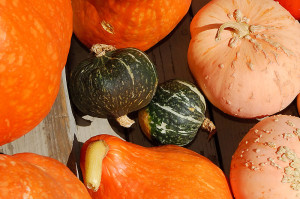
Anna Swartz Hubbard (dark green striped squash in center) produces small sized, manageable fruits, unlike some of its other Hubbard squash cousins
This variety is supposed to have excellent storage qualities, but I doubt we’ll be keeping these long enough to worry about storage.
Boston Marrow (C. maxima), there is no question, was hands down the star of the squash patch this year. This squash is not only prolific, but earned a spot in Slow Food’s Ark of Taste as a result of its superior flavor. This old heirloom variety has more than 200 years of documented history. Fruits average between 10 to 20 pounds.
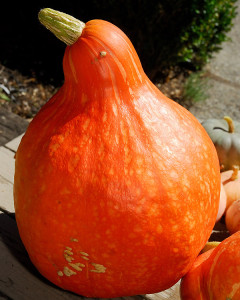
Big, beautiful Boston Marrow had very vigorous vines that ran the length and breadth of the squash patch, and produced a lot of very large fruits
Our largest this year was 18 pounds! Impressive considering the damage this year to the plants. This is a long storage squash, and under ideal conditions should last until spring, and is traditionally used as a pie squash because of its fine texture. However, I’m also curious to try it in a winter soup. If this squash delivers on flavor, it will become our new favorite winter squash here.
Galeux d’Esyines (C. maxima) was a surprise, in that we expected some of the decorative pumpkins may not yield well, but this variety in fact was one of the better producing pumpkins this season.
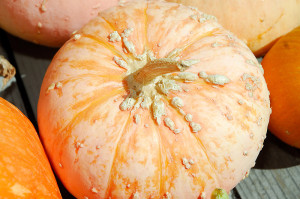
Galeux d'Esyines is a warty pumpkin, that's prone to splitting if left on the vine too long. That wasn't a problem though, as the voles ate the vines while the fruits were still small.
It’s also one of the most uniquely attractive. These were somewhat undersized at 6lbs, and should typically range between 10-20.
Next year we’d love see how these do once the meadow voles have moved on, and the fruits can grow to full size.
Gill’s Golden Pippin (C. pepo) was beautiful, and prolific. It’s good that it was prolific because this was the most favorite of all the squash from our vole’s perspective.
These small yellow acorn squash plants were relentlessly gnawed on, and sadly the harvest is rather scant as a result this year. This is apparently one of the best tasting of all acorn squashes, and we can’t wait to try it. Next year though, we refuse to lose these to the voles!
Greek Sweet Red (C. moschata) is an anomaly in the winter squash patch this year. For some reason these vines are only just now starting to set fruit. Perhaps like our tomatoes this year this variety was set back by our cool and foggy summer. When mature they somewhat resemble an elongated butternut squash, both in shape and color, and should have a rich sweet flavor. They look promising, but it’s a little too early to tell how they’ll do overall. We’re not sure they’ll ripen before the season ends.
Jarrahdale (C. maxima) was almost a total loss, but it seems that one vine was spared. Jarrahdale is not a prolific producer even in ideal conditions, and in fact, the one vine that remained in the squash beds only produced a single, beautiful, grey-green pumpkin, but at least we have one to show for our efforts. In addition to being decorative, this is a long storage variety, with dry flesh, and good used in soups, breads, and muffins, but it’s almost too beautiful to eat!
Marina di Chioggia (C. maxima) tried to do well, and set lots of fruit, but she was the third favorite after Gill’s and Anna for the rodents, so although fruit was set, the vines were destroyed before they had a chance to mature. This should have been a lovely green warty pumpkin, weighing in at around 10 pounds, but it never had a chance. Next year, maybe we’ll try again.
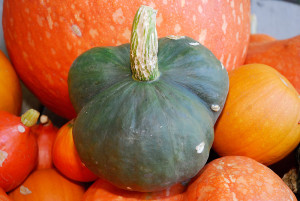
Marina di Chioggia shouldn't look like this. It should be a beautiful, large round wart-covered pumpkin, but the vines were killed before the fruits matured
Musquee de Provence (C. moschata) I like happy endings. This variety, we thought, had been obliterated at the time we published our vole post, but it seems they missed at least part of one vine, and so did we! While out harvesting, I was shocked when I uncovered not one, but two unmistakably ribbed pumpkins.
As most of the harvest is in, we’ve left these to mature a little longer, realizing we’ve now put them in serious jeopardy. Although the vole trapping does seem to be effectively reducing the population, they’re still out there, lurking.
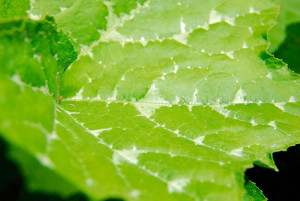
The leaves of Musquee de Provence were the prettiest of all in the squash patch. Medium green, flecked all over with silvery-white spots
Hopefully our rogue rodents will leave them alone while they finish ripening. We’ll have to see. Typically this variety ranges between 8-15 lbs, and is a long storage variety.
Potimarron (C. maxima) did have good fruit set, and the voles were gracious enough to leave a few to mature. We’re excited to try this variety as the flavor is said to be reminiscent of chestnuts.
If Red Kuri (C. maxima) looks remarkably similar to Potimarron, that could be because they’re essentially the same squash. The French call it Potimarron, and the British often refer to it as Onion squash. There is a subtle difference in coloring between the Potimarron and Red Kuri we grew this year, but we’re most curious to see how the the flavor compares between the two, and if we can discern a difference. The Potimarron plants weren’t as productive as Red Kuri, but I suspect that had more to do with the fact that Potimarron was planted just down hill from Gill’s Golden Pippin, and our lazy voles ate whatever was nearby.
Waltham Butternut, well, what can I say, there’s a reason this variety is popular. It’s traditionally been my favorite winter squash, and this year the plants set a lot of perfect small fruits. Long storing, with sweet flesh, ours are destined for lots of scrumptious butternut squash soup, and homemade roasted butternut squash ravioli!
So despite tremendous challenges in the garden this summer, with weather, and ravenous rodents, we still, no doubt in large part thanks to our bees, managed to eek out an acceptable winter squash crop.
We have yet to taste-test most of these varieties, and that ultimately will dictate which varieties we plant again. So far, of the varieties we tried this year, the only squash we’d not grow in the garden again is the Early Prolific Straight summer squash. Although it’s seedy texture is preferred by our chickens and turkeys, we don’t much care for it.
Gill’s Golden Pippin it seems is an excellent trap crop, so if we need to get creative catching voles next year, perhaps we should plant this at the other end of the orchard as a diversion.
Jarrahdale, from a productivity perspective would ordinarily be culled from our list. It takes up a lot of space, for very little in return, but it’s such a distinctive looking pumpkin, I’m sure we’ll find ourselves growing it again, even if its just to decorate the Thanksgiving table.
There is no doubt however, unless the flavor turns out to be massively disappointing, that we’ll be growing Boston Marrow again next year.
The entire project was worth it just to discover this variety, and who knows, it may even dethrone my beloved Waltham Butternuts as King of our fall and winter kitchen. We’re going to need a bigger soup pot!

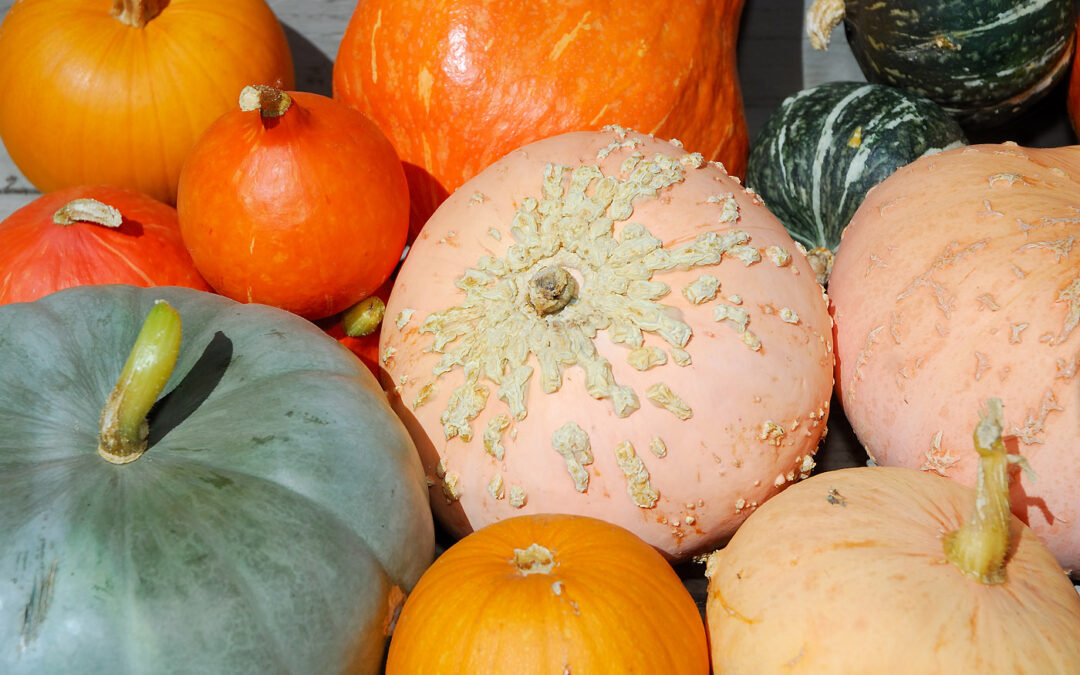
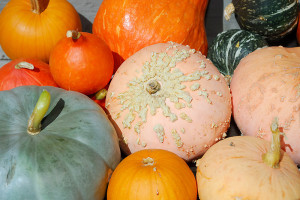
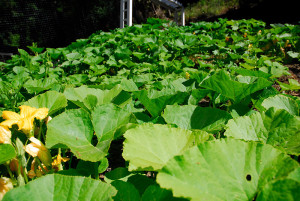

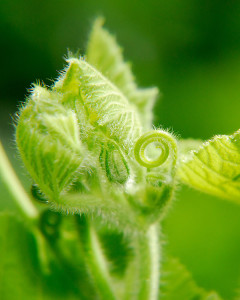
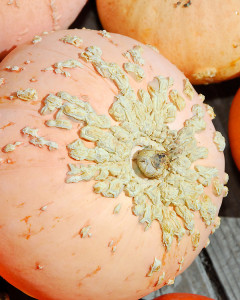
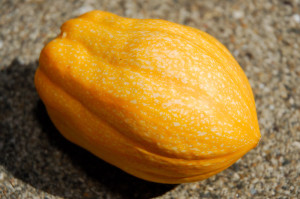
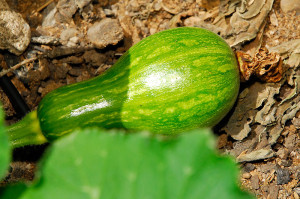
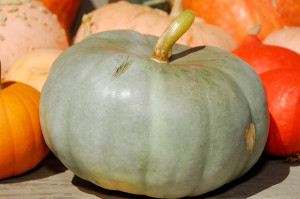
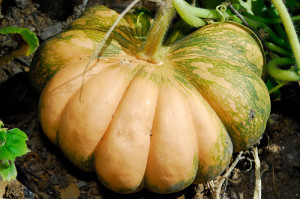
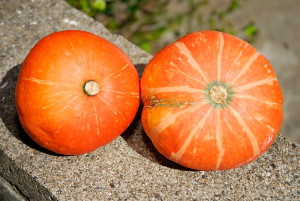
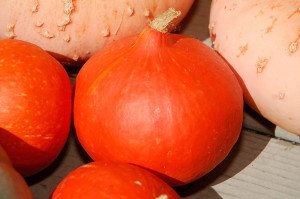
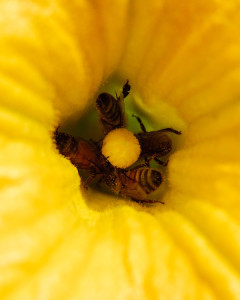
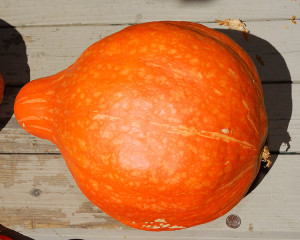







What a fabulous experiment!!! I think the idea of planting a diversion crop is excellent. 🙂 The squash are all so beautiful, esp. the blue pumpkin. I love the treasure hunt aspect of harvesting veggies, esp. when you find one that was hiding.
We were thrilled to find Musquee, it’s such a beautiful squash, and supposed to be very tasty too!
I have often thought of adding some additional squash varieties to the summer garden, but I usually end up with crookneck, yellow squash, and zucchini. Seeing these lovelies has inspired me to add some other for next year.
We planted them all at the same time, and it is nice to know that even after the summer squash are long done, that you’ll still have the winter squash to draw from because they store for so much longer. What I love about the winter squashes, is for most of them I can ignore them until the busy harvest season is over. There’s enough canning and preserving going on in late summer, without having to rush to use them. I do recommend though, if you grow winter squash, to start with a variety that is known to do well in your area, and try to select a long-storage type.
Ooh, I’m so envious. Such a brilliant harvest.
I only wish I had the room to grow a few!
Having a trap crop is new to me. I’m fixated on tasty recipes for the fall and winter.
Take care and enjoy this glorious weather before the winter rains;-]
The squash did take up some space in the garden, but that’s one of things I like about being here. I couldn’t have planted this much variety in our previous gardens.
Trap crops typically aren’t used for mammals 😉 Usually a trap crop is used to attract insects, aphids for example, to something they relish, to encourage them away from the crop you actually want to harvest.
It does seem though that Gill’s Golden Pippin was so attractive to our voles, that placing traps under those plants was much more effective this year. Next year though, maybe they’ll find a different variety more tasty!
The thought of having to consume all the squash I see in the photographes fills me with dread, having been traumatized as a child by squash eating requirements at the dinner table. I so appreciate the different shapes and colors of the various heirloom squashes you’ve grown however. They ARE beautiful!
Sue, I was just like you once. I spent a year as a child living in Canada, and our host had this obsession with squash, but she wasn’t a very good cook. I loathed, and dreaded the mere sight of a split, and roasted squash. I remembered it as being bitter, and almost impossible to swallow.
I think the tricks with winter squash are to try many different varieties. Find ones you actually like. I don’t like all of them equally, and that’s where taste testing these will be important.
Roasting any squash makes it sweeter, and can help with the bitterness of some varieties, but using them in things like soups, and raviolis, or breads and muffins, also means that the squash doesn’t have to be quite so central, and can married with other flavors.
I’m glad I worked through my winter squash phobia now, and some varieties, like my favorite butternut, I couldn’t now imagine being without. The most important part is learning how to prepare it, well!
I look forward to seeing the recipes you make if you post some. I DID get over my liver phobia, a good pate did the trick. 🙂
The warts are very interesting. I wonder what causes them to develop as the squash approaches maturity…
I don’t know exactly, but I have seen where some have intentionally bred newer varieties for the trait. It’s clearly genetic, but its expression seems variable, both in timing, and degree of warting. I’ve seen some more mature Galeux d’Esyines that are almost entirely covered in warts, where you can barely see any of the peach colored skin. Why exactly this variety gets wartier (is that a word?) with age, I couldn’t say!
Hi Clare,
Interesting post, two veggies I’ve never tried growing before, but they are so very colourful!
I look forward to seeing your taste reviews and other interesting ways you decide to cook them 🙂
I look forward to tasting them! 🙂
Clare, this is such a beautiful display of such variety. The nursery farm grows many of the varieties you have shown because one of the relatives has a produce store where they sell the veggies and fruit. The farm workers care for the plots. I was in the field with the squash and pumpkins the other day and did not think to photograph them, but they do take pretty images. But what I did notice was how many seemingly perfectly good zucchini and yellow squash were bored out straight through. Also the caterpillars were munching away from the outside. The farm is organically grown and tended, and luckily, the fields are pretty large of each to share with the voles and fuzzy caterpillars. Only the fruit trees get spayed and some of the nursery trees, otherwise it really would be insect heaven there.
Honestly, I think if we hadn’t planted multiple plants for each variety, we wouldn’t have been successful at obtaining squash from each type. Entire plants were chewed from their roots in late spring. Planting enough plants to outnumber the voles though is a challenge, at least on our tiny farm. Diligence with trapping during winter and spring will be critical before planting out next year. Need to nip the population before it explodes next spring. 😉
It is so heartwarming to see a bountiful harvest! I am looking forward to my squash patch looking like yours 🙂
Well, as long as you don’t have voles to worry about, your squash patch should probably do better than ours!
I looks like your farm has had a better crop of squash than we did. You have many enviable varieties in your trial. We at least did not have a rodent problem or chilly weather this summer.
It’s amazing that for most of the country it was one of the hottest summer’s on record. The wildfires in areas like Texas were phenomenal too. Here, we were mostly blanketed in fog. Great for growing greens, for tomatoes, not so so much 😉 I think our squash, even with all the vine damage, did better than our tomatoes this year 🙁
What a great variety you grew! They all look so special and unique. I bet they are delicious. The warts, though, do bother me a bit! Zucchini fritters! Thanks for mentioning that – I now know what we’re having for supper!
The warts are a little funny looking, but perfectly harmless. Might prove to be somewhat challenging to cut through though, we’ll have to see. Hope you enjoy the fritters!
What a phenomenal experiment! Thank you for sharing everything you learned!
This is the first time we’ve really had the space to do this, and it was a lot of fun. Next year we’ll have to see if we can come up with some more unique varieties to try.
I love this experiment and look at the wonderful fruit…I have voles issues as well and they are impossible to manage without some serious natural hunters. My pumpkins did not pollinate even with the flurry of bee activity ;(
I’m so sorry you have voles Donna, I really do feel your pain. I always thought gophers were destructive, but they’re fat, slow, and somewhat more predictable, making them much easier to trap. I just refuse to use poison baits here, it’s not worth the risk, so it just will require a little extra effort on our part to keep them in check, and accept that there will, occasionally, be losses. I’m hoping next spring we have more owls 😛
Bad voles! You have got a wonderful variety of shapes and sizes. Some of them are so unusual they are almost works of art.
I agree, it’s going to be difficult to cut into some of these, they are beautiful!
Goodness that must have taken up some room. I have two vines this year (inadvertently started in the compost) and they take up a massive amount of space. Love all the different fruits and the pictures of each. The Fairytale pumpkin has to be my favourite. Had no idea voles would each the vines. Thank goodness my voles haven’t discovered these yet but will keep it in mind next year when planting. Thus far they only like really expensive and rare trees. Perhaps my squash are too cheap for them.
They did take up a lot of space. The trouble with voles, is they like lots of overhead cover. The trouble with squash, is they grow LOTS of overhead cover. We’re considering planting fewer squash next year, further apart. The closer spacing did help protect the roots from drying out, but didn’t protect the plants from sharp teeth. The voles definitely change up the way we have to plan our gardens. Oh, and don’t worry, they took out one peach, and one pear tree too. We’ll be replanting Frost peach, and Bosc pear this winter 🙁
So impressed with the huge variety, Clare. A huge lover of squash, I would be in ‘Squash Heaven’!
I think I am in squash heaven. I would have been just with all the butternuts, but can’t wait to try some of these, especially Boston Marrow and Potimarron 🙂
I almost didn’t get back to this post. I got carried away looking at old photos. I’m getting used to the ‘new’ layout and liking it more each time I see it.
I love growing squash but hate eating it. Something about the texture freaks me out so my wife makes a lot of pumpkin and squash breads 🙂
There’s nothing wrong with eating squash in breads and muffins! I think that’s a fine way to eat it 😉
What a great experiment! There’s a couple of the winter squashes that really sound interesting to me. I’m glad the pesky voles left you some for harvesting. I only have room for a few vining squashes each year, but I always like trying new (or old) varieties. I’m dying to hear how the Boston Marrow tastes. Some of my favorites are on that Ark of Taste list, so it’s in great company.
I gave up on the Early Prolific squash too. Our hot summers seem to make it toughen up super quick.
I think Boston Marrow may yield it’s own post, not just for flavor, but also because it will be fun to document how many different things we had to make just to use up one of them! 😛
GORGEOUS!!! Despite the goofy weather you pulled off a great harvest. Really great-looking stuff, what lovely vivid colors! I love Fall so much.
With tomatoes (finally) ripening, winter squash season upon us, the flavors of fall make this one of my favorite times of year too! 🙂